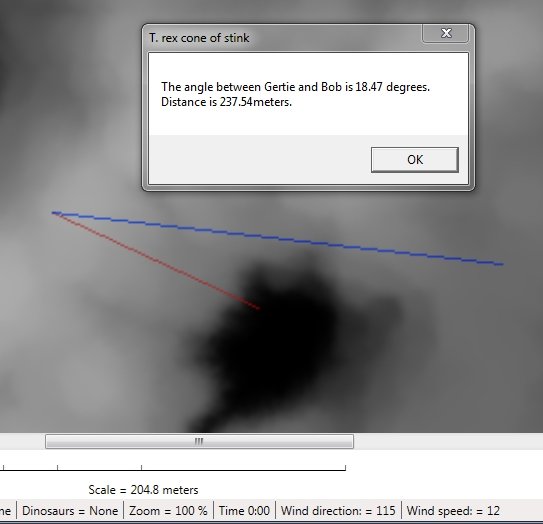
Calculating the direction and intensity of the smell from a T. rex. Note wind direction and speed at bottom. The red line is the direction that the T. Rex named Bob’s scent is being carried. Angle from Gertie to Bob is blue line. Screen capture from Dinosaur Island AI testbed (click to enlarge).
Yes, it has come to this: we are calculating the ‘cone of stink’ of a T. rex.
I’m working on not just the ‘combat models’ for Dinosaur Island see (“Creating a combat model for T. rex versus Edmontosaurus regalis“) but the AI that drives the decisions and actions of the dinosaurs as well. While creating the AI I realized that scent was probably as important as sight to any dinosaur that didn’t want to become dinner. At the same time, predators – successful predators – should take wind direction into consideration when planning their attacks and consequently maneuver to be downwind of their prey.
After watching a number of predator / prey scenarios in Dinosaur Island I became convinced that the T. rex didn’t just see an Edmontosaurus from 500 meters away and start charging towards it. I think the T. rex maneuvered into position (downwind) and only then ran at top speed when it was within 50 meters of the victim. I don’t think that a T. rex had energy to burn – and they sure burned a lot of energy running with all that weight at top speed – and even an unarmored prey like Edmontosaurus could pack a terrific wallop with its tail if it was forewarned.
As we shall see in the next few postings, dinosaur predators were not just big dumb brutes and scavengers. For them to survive they had to plan their attacks in advance or be incredibly lucky. Also, we shall see how ‘olfactory acuity’ and ‘angle of vision’ played an important role in detecting predators before it was too late for big herbivores like Edmontosaurus and that the key to their survival involved group defensive tactics.

For the feature of players being able to enter individual dinosaurs and control them, have you thought at all about if/how you’re going to display the perception of scent to the player? I’ve seen a couple attempts in games about wolves (e.g., the creatively named WolfQuest, and the even more creatively named Wolf), but no other really serious treatments of how to depict non-human senses. The only other sense I’ve seen attempted is thermographic vision. I’ve been waiting to see someone try to do something with sharks’ ability to smell blood, or even their electroreception (ooh, or spiders’ vibration sense, now that all these controllers have vibration feedback), but not a lot of people seem to be interested in making those sorts of games right now.